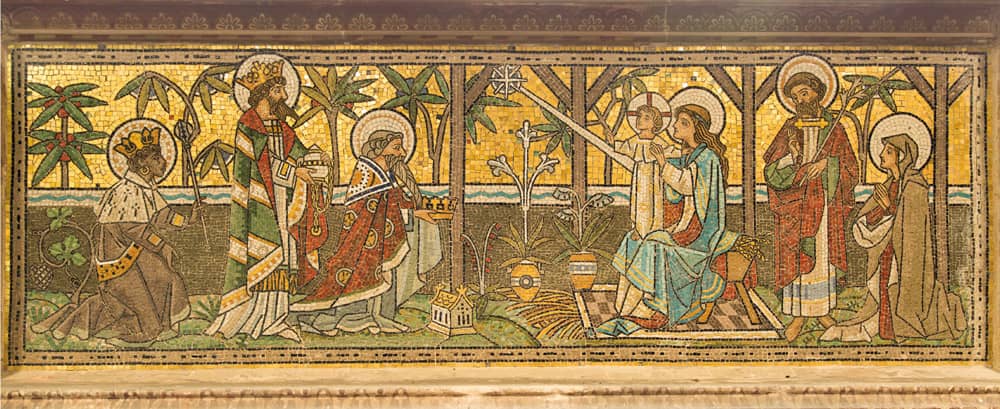A tour of All Saints
Sir John Betjemen the Poet Laureate, has written of All Saints, Calverton, that “it is a stately piece of Victorian re-building (though original Georgian construction) with a solid Norman revival tower, the rest being sumptuously mid-Victorian consisting of rich carving in stone and wood. The Tractarian chancel has a carved and gilt reredos seen through a forest of candles“.
There is a west tower with a large door leading into the nave, used primarily for ceremonial occasions. Entry into the Church is by way of the porch on the south side and this leads into the south aisle. Walking east (that is to the right) down this south aisle one comes to the newly restored Baptistery. The font had previously been moved sometime before to west-end of the nave under the tower. Before being restored as a Baptistery the south aisle had been used as a children’s chapel, although there is record of it ever having an altar. In the baptistery there is an excellent stained glass window illustrating Our Lord’s Nativity (the Christmas scene). It is well worth studying and quietly thinking about.
Above this window are inscribed the words “One Faith, One Lord, One Baptism”: to remind us that here it was that both children and adults were admitted into Christ’s Church. If you look over the top of the back of the organ you will see another scripture text referring to the Lord’s welcome of children.
At the entrance to the baptistery there is a large brass plate set into the floor. This is a rather curious memorial as it commemorates the deaths of John Robys and his wife, with the date of John’s death. Although his wife is also to be remembered and prayed for her date of death is not inscribed. It would appear, therefore, that this memorial was engraved before the wife’s death. It is of sixteenth-century origin and retained from the old church.
Proceeding into the nave from this south aisle, one passes under one of three pointed arches: the pillars supporting these arches are also part of the old Church that is pre-1818.
Looking west there is a newly installed (2005) oak screen at the tower arch which discreetly shields from view the newly installed water facilities. Beyond this screen, within the tower area are two interesting pictures of the “old” Church.
Walking up the nave from the tower can be seen the three stained-glass windows containing the figures of the Saints. Wherever you sit in this church there is always a saint to catch your eye. The pulpit has images of saints, Peter, Paul, Barnabas and John the Baptist.
The roofs of the Nave and Chancel are of wood with carvings of angels. The Carved Angels were professionally cleaned (by Eric West) and the Corbells were restored and as a result now look fantastic once more. Approaching the Chancel, the east window depicts the Crucifixion of Our Lord, His being laid in the tomb and His Resurrection. This reminds us of His sacrifice on our behalf and which we recall through the priest each time the Mass is celebrated at the Altar immediately below this window. Mary, the mother of Jesus, is seen in this window too, as also are Saints Peter, Paul, John and Stephen. The south window depicts Saints Thomas and Andrew and in the north window can be seen the figures of Saints James and Bartholomew.
Behind the Altar is the reredos, an ornamental covering of the wall beneath the east window. Here can be seen a very elegantly carved picture decorated with mosaic tiles of the Adoration of the Magi. These were the first Gentiles (non Jews) to believe in Christ and such scenes as the one on this reredos were, from early times, extremely popular in Christian art. Note here that Christ is a small boy rather than an infant. This is consistent with the scriptural account where we are told that King Herod ordered the slaughter of all the boys in Bethlehem below the age of two. The Magi come to worship Christ and here again this is appropriate as we come to the Altar rails to make our Communion, so we gaze upon those early Christians showing reverence and devotion to the Child Jesus. This in turn aids us in the twenty-first century to raise our thoughts to heavenly things and to lift up our hearts as we receive our Lord Jesus Christ in the Most Holy Sacrament of the Altar.
